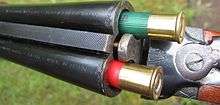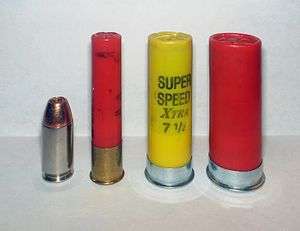.410 bore
| .410 bore | |
|---|---|
|
| |
| Type | Shotgun, revolver, single-shot pistol |
| Place of origin | England |
| Production history | |
| Manufacturer | Eley Brothers |
| Produced | 1874 onwards |
| Specifications | |
| Case type | Rimmed, straight, (optional plastic) |
| Bullet diameter | .410 in (10.4 mm) (slug) |
| Neck diameter | .455 in (11.6 mm) (plastic) |
| Base diameter | .470 in (11.9 mm) |
| Rim diameter | .535 in (13.6 mm) |
| Rim thickness | .060 in (1.5 mm) |
| Overall length | 2", 2.5", 3" |
| Rifling twist | N/A |
The .410 bore, commonly yet incorrectly named .410 gauge, is the second-smallest caliber of shotgun shell commonly available, (.360 CF being the smallest). It has similar base dimensions to the .45 Colt revolver cartridge, allowing many single-shot firearms, as well as some derringers and revolvers chambered in that caliber to fire shot without any modifications, though the .410 is significantly longer, up to 3 inches (76 mm).
Origin
Lancaster's pattern centerfire and pinfire .410 shot cartridges first appeared in Eley Brothers Ltd. flysheets in 1857. By 1874, Eleys were advertising modern centerfire .410 cartridges.[1] It appears to have become popular around 1900, although it was recommended as "suited to the requirements of naturalists, and for such weapons as walking-stick guns", presumably for self-defense, in 1892 by W. W. Greener.[2] The first ammunition was 2.0 inches (50.8 mm) long, compared with the modern 2.5 and 3.0-inch (76 mm) sizes.
Uses
As the smallest of traditional shotgun sizes, .410 bore guns throw the least weight of shot, but are very easy to handle. This results in a very low recoil, so the .410 is often chosen for young shooters, who might have problems with a heavier recoiling shotgun. Some shooters, however, discourage the use of the .410 as an introduction for young shooters, both because the negligible recoil does not familiarize the beginners with the heavier recoil of larger cartridges such as the 12 gauge, and because of the difficulty in hitting moving targets with the small charge of shot used by the .410. Others believe starting young, new, or small shooters with heavy recoiling guns will cause a habit of flinching and negatively affect their accuracy.
Some competitive shooters choose the .410 bore because of the challenge it presents; .410 bore guns generally have full chokes to form a tight pattern with the small load of shot, and this makes hitting moving targets very challenging. By using sub-gauge inserts, a 12 gauge break-open action can be temporarily converted down as far as a .410 bore to provide an additional challenge when training, or to handicap the shooter.
The .410 bore is also commonly used for small game animals such as squirrels and rabbits, where the small diameter patterns of a full choke are less problematic than with birds.
The .410 bore is inferior to the traditional 12 gauge shotshell for defensive use,[3] though a number of companies market defensive guns chambered in .410, such as the Mossberg 500 home security model. Defensive ammunition is becoming easier to find although most .410 bore shells remain loaded with birdshot. American Derringer and Winchester market .410 bore 000 buckshot with five pellets in 3-inch (76 mm) and three pellets in 2.5-inch (64 mm) shells,[4][5] compared to twelve pellets of 00 in a three-inch 12 gauge and nine pellets of 00 in a 2¾ inch 12 gauge.
Survival arms
The small size of the .410 bore makes it popular for use in compact firearms carried for emergency use. These are often combination guns, with a .22 Hornet or .22 rimfire rifle barrel mounted over a .410 bore shotgun barrel. The most famous of these is the M6 survival rifle made by Springfield Armory, Inc. for the US Air Force, and a number of copies are made by other makers. The original has a 14-inch (360 mm) barrel, the same length as the stock, and folds in half for storage, making a compact package. With the short barrel, this is classified as an any other weapon in the United States, so 18.5-inch (470 mm) barreled models are made for civilian sales, as well as a 16-inch (410 mm) pistol version in .22 over .45 Colt.[6] Special flare cartridges in .410 were issued with the USAF model.

The Thompson Center Arms Contender pistols are commonly encountered with a special .45 Colt-.410 bore barrel. The barrel is rifled for the .45 Colt, but has a special choke and vent rib to make it function as a shotgun. Due to the rifled barrel, the assembled firearm is considered a rifle or pistol (depending on barrel length) and thus is not subject to the National Firearms Act's 18-inch (460 mm) minimum barrel length.[7] Nonetheless, possession of a Thompson Center Arms .45-.410 pistol barrel is illegal in California, for both dealers and individuals, and such a barrel may not legally be shipped into the state, or even taken into California for a hunting trip, by reason of it being classified as a short barreled shotgun (SBSG) when used with a Contender receiver.[8]
Handguns
The fact that the .410 bore shell fits in a .45 Colt chamber has resulted in some unusual applications. While shotguns are often limited in minimum length, a firearm chambered in .45 Colt, such as the Contender pistol, is not defined as a shotgun even though it can chamber shotgun shells, since the barrel is rifled, not smooth. American Derringer has long offered .45 Colt-.410 bore Derringers,[9] and recently Taurus, Magnum Research, and Smith & Wesson began to offer revolvers with extended cylinders, chambered for .45 Colt but long enough to hold .410 shells as well. Magnum Research offers a single-action revolver in their BFR (Big Frame Revolver) line, while the Taurus Judge is similar in price to their other double-action revolvers, with the Raging Judge model capable of chambering and firing the .454 Casull cartridge. The Smith & Wesson Governor is a double-action revolver also capable of firing .45 ACP cartridges with the aid of moon clips. The discontinued MIL Thunder 5 is also chambered in .410-bore.
Other firearm manufacturers, such as Bond Arms,[10] offer various Derringer models which chamber both .45 Colt cartridges and .410 shotshell.
Capacity, compared to other gauges

| Length & load | No. 000 buckshot (.36") | No. 4 buckshot (.24") |
|---|---|---|
| 2½", 410 bore | 3 or 4 pellets | 8 pellets |
| 3", 410 bore | 5 pellets | 9 pellets |
| 2¾", 12 gauge | 7 pellets | 34 pellets |
| 3", 12 gauge | 9 pellets | 41 pellets |
The bore designation of the .410 bore is unique among shotgun cartridges. Other shotgun cartridges are measured in terms of shotgun gauge. Shotgun gauge is determined by the weight of a round lead ball that is sized to fit into its barrel. For example, the barrel of a 12-gauge shotgun is equal to the diameter of a 1/12th pound lead ball and a 20-gauge can fit a 1/20th pound ball. Using this method a .410 bore is equivalent to a (hypothetical) 67-gauge (see Shotgun gauge).[11]
References
- ↑ Eley Cartridges by CW Harding (2006)
- ↑ William Wellington Greener (1892). The Breach Loader, and How to Use It. Forest and Stream Publishing Co., New York. p. 45.
The 28-bore is the smallest of any practical use as a game gun, but the 410 and other sizes are suited to the requirements of naturalists, and for such weapons as walking-stick guns.
- ↑ Chuck Hawks' updated rec.guns FAQ on defensive ammunition
- ↑ Winchester .410 buckshot
- ↑ American Derringer .410 buckshot
- ↑ S. P. Fjestad. Blue Book of Gun Values, 13th Ed. Blue Book Publications.
- ↑ "G2 Contender Pistols". Archived from the original on 25 October 2007. Retrieved 2007-09-20.
- ↑ "California Dangerous Weapons Control Law ARTICLE 2. UNLAWFUL CARRYING AND POSSESSION OF WEAPONS 12020.". State of California. 2008. Retrieved 2013-01-29.
As used in this section, a "short-barreled shotgun" means any of the following: (A) A firearm which is designed or redesigned to fire a fixed shotgun shell and having a barrel or barrels of less than 18 inches in length. (B) A firearm which has an overall length of less than 26 inches and (farming simulator) which is designed or redesigned to fire a fixed shotgun shell.
- ↑ American Derringer model 1
- ↑ Bond Arms
- ↑ "Ball Weight and Density". Archived from the original on 2012-02-18. Retrieved 2012-02-16.
External links
- The Shotgun Report review of the Remington 870 in 28 gauge and .410 bore
- The .410 Bore by Chuck Hawks
| Wikimedia Commons has media related to .410 bore. |
